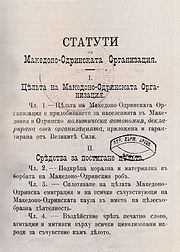
Supreme Macedonian Committee
Encyclopedia

Macedonia (region)
Macedonia is a geographical and historical region of the Balkan peninsula in southeastern Europe. Its boundaries have changed considerably over time, but nowadays the region is considered to include parts of five Balkan countries: Greece, the Republic of Macedonia, Bulgaria, Albania, Serbia, as...
and Thrace
Thrace
Thrace is a historical and geographic area in southeast Europe. As a geographical concept, Thrace designates a region bounded by the Balkan Mountains on the north, Rhodope Mountains and the Aegean Sea on the south, and by the Black Sea and the Sea of Marmara on the east...
regions of the Ottoman Empire
Ottoman Empire
The Ottoman EmpireIt was usually referred to as the "Ottoman Empire", the "Turkish Empire", the "Ottoman Caliphate" or more commonly "Turkey" by its contemporaries...
, and in Bulgaria
Bulgaria
Bulgaria , officially the Republic of Bulgaria , is a parliamentary democracy within a unitary constitutional republic in Southeast Europe. The country borders Romania to the north, Serbia and Macedonia to the west, Greece and Turkey to the south, as well as the Black Sea to the east...
from 1895 to 1905. Macedonian Bulgarian and Thracian Bulgarian
Thracian Bulgarians
Thracians or Thracian Bulgarians is a regional, ethnographic group of ethnic Bulgarians, inhabiting or originating from Thrace. Today, the larger part of this population is concentrated in Northern Thrace, but much is spread across the whole of Bulgaria and the diaspora...
emigrants in Bulgaria were a great number. They formed in 1895 the “Macedonian-Adrianople Organization”, at the head of which was “Supreme Macedonian-Adrianople Revolutionary Committee”. Its official declaration was also a struggle for autonomy
Autonomy
Autonomy is a concept found in moral, political and bioethical philosophy. Within these contexts, it is the capacity of a rational individual to make an informed, un-coerced decision...
of Macedonia and Thrace. At the same time, being impatient for the liberty to come sooner, and strongly convinced that it would come only with the help of the Bulgarian Army. Later they directed their efforts in activities for involving the country into war with the Ottoman Empire. As a rule most of the leaders were with stronger connections with the governments. At the end their main idea was, waging struggle for a direct unification with Bulgaria.

Yane Sandanski
Yane Ivanov Sandanski or Jane Ivanov Sandanski, was a revolutionary, one of the leaders of the Internal Macedonian-Adrianople Revolutionary Organization in the Serres region and head of the extreme leftist wing of the organization...
and Hristo Chernopeev
Hristo Chernopeev
Hristo Chernopeev was a Bulgarian revolutionary and member of the revolutionary movement in Macedonia...
, who were later to become the leaders of the IMARO left wing. During the Ilinden Uprising insurgent detachments of the Supreme Committee, held down a large Turkish force. These actions began on the day of the Feast of the Cross
Feast of the Cross
In the Christian liturgical calendar, there are several different Feasts of the Cross, all of which commemorate the cross used in the crucifixion of Jesus....
and did not involve the local population as much as in other regions, and were well to the east of Monastir and to the west of Thrace. After the failure of the uprising the Bulgarian government dissolved the Committee under Ottoman pressure.
See also
- Trayko KitanchevTrayko KitanchevTrayko Tsvetkov Kitanchev was a Bulgarian teacher, social figure, poet and revolutionary. In 1895, he was the first chairman of the Supreme Macedonian–Adrianopolitan Committee, a Sofia-based organization seeking the autonomy of Macedonia and southern Thrace....
- Internal Macedonian Revolutionary Organization
- History of BulgariaHistory of BulgariaThe history of Bulgaria spans from the first settlements on the lands of modern Bulgaria to its formation as a nation-state and includes the history of the Bulgarian people and their origin. The first traces of human presence on what is today Bulgaria date from 44,000 BC...
- Ilinden Uprising

